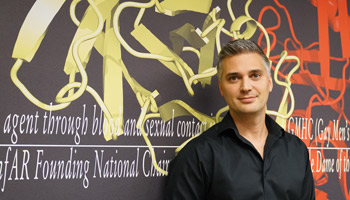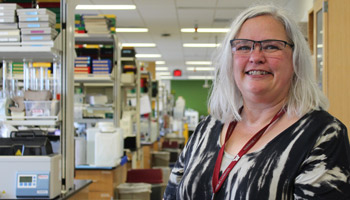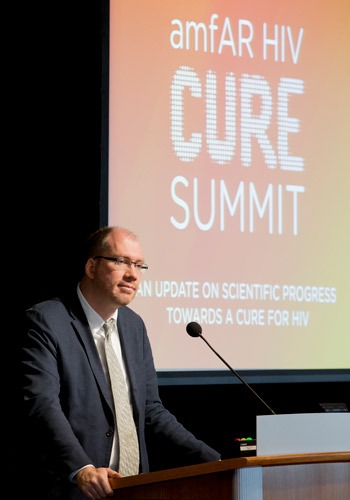The Road Ahead
A status report on HIV reservoirs and eradication strategies
Some 400 HIV researchers from around the world gathered in Miami, December 13–16, for a biennial conference that is widely recognized as the reference workshop on HIV reservoirs and eradication strategies.
The 10th edition of the HIV Persistence During Therapy conference covered the gamut of recent HIV cure research findings, including basic, preclinical, and clinical studies, and featured a number of amfAR grantees. Topics included virology and immunology of HIV persistence, drug discovery and development, pharmacology, cell and gene therapy, and antibody and immune-based therapies.

An opening lecture was delivered by German physician and researcher Dr. Gero Hütter, who is credited with conducting the groundbreaking stem cell transplant procedure that led to the first-ever case of an HIV cure—Timothy Ray Brown. Dr. Hütter summarized how much we have learned since that case was published in 2009, and how much is still to be done.
Today, stem cell transplants with cells from donors who harbor the CCR5 delta32 mutation remain the only means of completely eradicating HIV from the body. amfAR grantee Dr. Jonah Sacha, from Oregon Health and Science University, created an animal model to better understand the necessary components of such cures. Transplanting cells with intact CCR5, he characterized differences between cases when virus was cleared versus when it was not.
There is particular interest in the potential for antibodies to at least control infection, or to perhaps even target and eliminate reservoir cells.
In a scientific coup, Dr. Sacha captured under the microscope the moment a donor cell lacking the mutation was infected by one of the few viruses remaining in the recipient animal. This explains how even when a transplant recipient’s entire immune system is replaced by cells from the donor, HIV infection can persist. It is particularly puzzling that this infection of donor cells can occur even when the animal is taking antiretroviral therapy (ART), which should suppress any new infection events.

Most researchers in the field are pursuing curative approaches that are thought to be more easily scalable and less costly. There is particular interest in the potential for antibodies to at least control infection, or to perhaps even target and eliminate reservoir cells. Along those lines, the RIO study, led by Dr. Sarah Fidler in the UK, tests the ability of two long-acting anti-HIV antibodies to affect the ability of participants to control the infection after they stop taking antiretroviral therapy. Dr. Fidler provided intriguing but preliminary evidence that, depending on the timing of the antibody treatment, the duration of viral control without ART can be extended, although the virus was not eliminated.
Because of the inability to date of immunotherapy to clear the reservoir, there is growing interest in the potential of gene therapy to eliminate either the virus from inside infected cells, or the infected cells themselves. One example of such efforts was provided by amfAR grantee Dr. Pamela Skinner from the University of Minnesota. She is pursuing an approach that targets chimeric antigen receptor (CAR) T and other CAR cells directly to lymph nodes, where most of the virus is found. She and her team demonstrated that CAR T cells engineered to home in on the lymph node make appropriate contact with infected cells.

Finding HIV’s hiding places is a challenge addressed by amfAR grantee Dr. Timothy Henrich, from the amfAR Institute for HIV Cure Research at the University of California, San Francisco. His team was the first to develop a method of using PET imaging to directly assess which tissues in live humans harbor the greatest burden of virus, published in Nature Communications in March 2022. He reported further work by his team, describing how the HIV reservoir shifts location over the course of long-term treated HIV and new methods of measuring HIV activity inside lymph nodes in real time.
Most HIV cure studies are conducted in males harboring clade B HIV. Dr. Nancie Archin, from the University of North Carolina, provided an overview of what is known, and what remains to be learned, about sex differences in the HIV reservoir, citing amfAR’s own work in the field. And one of the most moving moments of the conference came from a talk given by Josephine Nabukenya, an advocate from Uganda, arguing passionately for more cure research in African populations.
The complexity of the task at hand was illustrated by amfAR grantee Dr. Eli Boritz, from the National Institute of Allergy and Infectious Diseases. Reporting on a study since published in Nature in January, he described a microfluidic technology many years in the making that was used to sort single infected cells out from the bulk of (uninfected) blood cells, so that each infected cell could be individually interrogated. His team found that the genetic programming of infected cells was altered so that the cells were more likely to survive, more likely to proliferate, and less likely to produce virus, the latter helping them to evade detection by the immune system.
Although there were promising hints of progress, there is clearly much research yet to be done to find an affordable, scalable cure to help end the HIV pandemic.
Share This:
